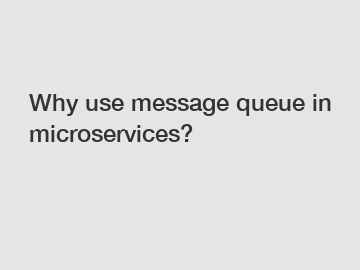Why use message queue in microservices?
Link to Vanus
Why Use Message Queues in Microservices?
In the world of microservices architecture, developers are constantly seeking efficient ways to handle communication between various services. With the complexity involved in building and maintaining microservices, it's important to have a reliable and scalable mechanism for inter-service communication. This is where message queues come into play.

Message queues act as a communication channel between different microservices, allowing them to exchange data and perform actions asynchronously. They provide a way for services to send and receive messages without having to know the specifics about each other. Let's dive deeper into why using message queues in microservices is a game-changer.
1. Scalability and Resilience:
Microservices architecture focuses on breaking down monolithic applications into smaller, independent services. Each service can be independently scaled based on demand. However, direct communication between services can become a bottleneck when dealing with heavy traffic. Message queues help address this challenge by decoupling the services, allowing them to communicate asynchronously. This increases the system's ability to handle spikes in traffic and makes it more resilient.
2. Loose Coupling:
By utilizing message queues, microservices achieve loose coupling. Services can independently evolve and scale without knowing the specific details of other services. A service only needs to know how to publish or consume messages from the queue. This loose coupling enables teams to develop and deploy services independently, making the overall system more maintainable and flexible.
3. Fault Tolerance:
In a distributed system like microservices, failures are inevitable. When a service is down or experiencing issues, messages can still be sent to the queue until the service recovers. This makes message queues an effective mechanism for handling failures and ensuring that no messages are lost. For example, if a service is temporarily unavailable, messages are buffered in the queue and then processed once the service is back online.
4. Event-Driven Architecture:
Message queues enable the implementation of event-driven architecture in microservices. Events can be produced and consumed by different services, allowing them to react to changes and trigger relevant actions. This makes the system highly responsive and adaptable to real-time changes. For example, an event could be triggered when a new order is placed, notifying other services to perform necessary actions such as updating inventories or sending notifications.
5. Service Decoupling:
Message queues facilitate decoupling between services by eliminating direct dependencies. Services can be developed independently, using different programming languages and technologies. As long as they can interact with the queue, they can seamlessly communicate with each other. This decoupling enables teams to choose the best tools and technologies for each service, promoting autonomy and innovation.
6. Load Balancing:
Message queues can be used to achieve load balancing across multiple instances of a service. Instead of directly sending requests to a specific service instance, requests can be distributed among available instances by the queue. This helps evenly distribute the workload, optimize resource utilization, and improve overall system performance.
7. Durability and Persistence:
In a microservices architecture, it's crucial to ensure that messages are not lost or duplicated. Most message queues offer persistence, where messages are stored until they are acknowledged and processed. This guarantees that no data is lost in case of system failures or crashes.
8. Choreography and Orchestration:
Message queues enable both choreography and orchestration patterns in microservices architecture. In choreography, services communicate with each other through events, collectively determining the system's behavior. In orchestration, a central coordinator (or orchestrator) controls the flow of messages and interactions between services. Message queues provide a reliable communication channel to implement both patterns effectively.
In conclusion, message queues play a vital role in the success of microservices architecture. They provide scalability, loose coupling, fault tolerance, and support event-driven systems. The decoupling between services, load balancing, durability, and choreography capabilities make message queues an essential tool for building robust and scalable microservices-based applications.
By adopting message queues in your microservices architecture, you can improve system performance, enhance fault tolerance, and maximize the flexibility and scalability of your application. Embrace this powerful tool and unlock the true potential of microservices.
Click here to get more.
For more is kafka a message queueinformation, please contact us. We will provide professional answers.



